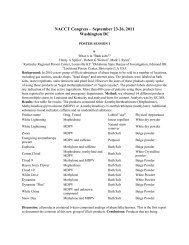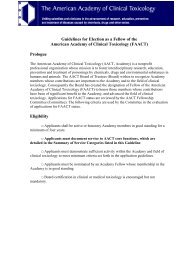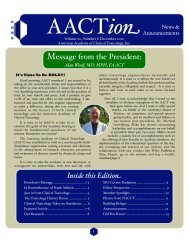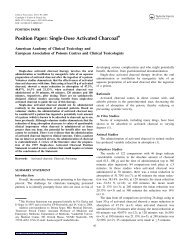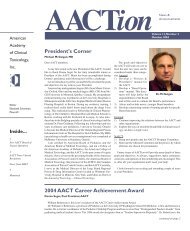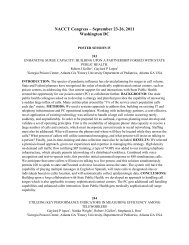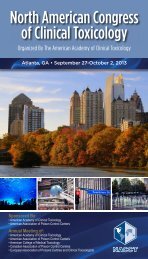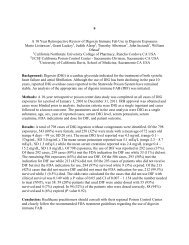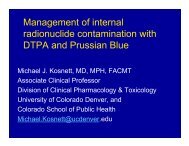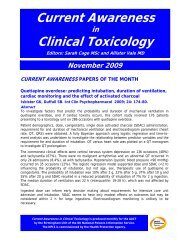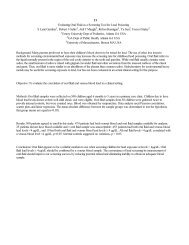NACCT Platform Abstracts 2012 - The American Academy of Clinical ...
NACCT Platform Abstracts 2012 - The American Academy of Clinical ...
NACCT Platform Abstracts 2012 - The American Academy of Clinical ...
You also want an ePaper? Increase the reach of your titles
YUMPU automatically turns print PDFs into web optimized ePapers that Google loves.
8<br />
Effectiveness <strong>of</strong> low dose naloxone to reverse respiratory depression in opioid intoxication<br />
Hong K Kim 1 , Lewis S Nelson 1<br />
1 New York University School <strong>of</strong> Medicine, New York NY USA<br />
Background: Although naloxone reverses the respiratory and CNS effects <strong>of</strong> opioids, care must be utilized to avoid<br />
precipitating acute opioid withdrawal syndrome (OWS). <strong>The</strong> commonly recommended initial naloxone dose <strong>of</strong> 0.4 mg is<br />
based on studies in a non-opioid-dependent population undergoing anesthetic reversal. However, in opioid-dependent<br />
patients, this dose predictably results in acute withdrawal. Despite limited data demonstrating the efficacy <strong>of</strong> a lower dose <strong>of</strong><br />
naloxone, 0.04 mg is <strong>of</strong>ten recommended in medical toxicology and anesthesia texts as safe and effective. <strong>The</strong> objective <strong>of</strong> this<br />
study was to evaluate the clinical effects <strong>of</strong> naloxone 0.04 mg (with titration) on the respiratory depression noted in ED patients<br />
with acute opioid overdose.<br />
Methods: A prospective observational study <strong>of</strong> the current ED practice <strong>of</strong> naloxone use in opioid intoxicated patients was<br />
conducted. Thirty consecutive ED patients, 18 years and older, with clinical findings <strong>of</strong> opioid intoxication (e.g., history, CNS<br />
depression, pinpoint pupils, RR < 8/ minute) requiring naloxone were included. <strong>The</strong> primary outcome was improved RR.<br />
Secondary outcomes were end-tidal CO2 level (CO2), pulse oximetry (O2 sat) on room air, Richmond Agitation Sedation<br />
Scale (RASS), and OWS.<br />
Results: Preliminary results involving five ED patients are summarized in the table. All five patients experienced coma with<br />
hypoventilation due to methadone use. On average, patients required two naloxone doses <strong>of</strong> 0.04 mg. One patient (patient D)<br />
experienced acute OWS with a total naloxone dose <strong>of</strong> 0.08 mg.<br />
Table<br />
Patient A<br />
Patient B<br />
Patient C<br />
Patient D<br />
Patient E<br />
Drug history <strong>Clinical</strong> findings Naloxone (mg) <strong>Clinical</strong> response<br />
Methadone<br />
Methadone<br />
Benzodiazepine<br />
Methadone<br />
Methadone<br />
Methadone<br />
RR: 6/min<br />
RASS: -4<br />
O 2 sat: 87%<br />
CO 2 : 50 mmHg<br />
RR: 7/min<br />
RASS: -4<br />
O 2 sat: 95%<br />
CO 2 : NR<br />
RR: 6/min<br />
RASS: -5<br />
O 2 sat: 80%<br />
CO 2 : NR<br />
RR: NR<br />
RASS: -5<br />
O 2 sat: 40%<br />
CO 2 : 60 mmHg<br />
RR: 3/min<br />
RASS: -4<br />
O 2 sat: 92%<br />
CO 2 : 55 mmHg<br />
IV: 0.04 x 2<br />
IV: 0.04 x 3<br />
Infusion: 0.04 mg/hr<br />
IV: 0.04<br />
Infusion: 0.05 mg/hr<br />
IV: 0.04 x 2<br />
Infusion: 0.1 mg/hr<br />
IV: 0.04 x 2<br />
Infusion: 0.05 mg/hr<br />
RR: 14/min<br />
RASS: 2<br />
O 2 sat: 95%<br />
CO 2 : 42 mmHg<br />
RR: 9/min<br />
RASS: -1<br />
O2 sat: 99%<br />
CO 2 : NR<br />
RR: 12/min<br />
RASS: 0<br />
O 2 sat: 92%<br />
CO 2 : 29 mmHg<br />
RR: 13/min<br />
RASS: 2<br />
O 2 sat: 99%<br />
CO 2 : NR<br />
OWS: vomitting<br />
RR: 6/min<br />
RASS: -2<br />
O 2 sat: 94%<br />
CO 2 : 50 mmHg<br />
NR: not reported<br />
Conclusion: A naloxone dose <strong>of</strong> 0.04 mg with appropriate dose titration can effectively reverse both respiratory and CNS<br />
depression. A total dose <strong>of</strong> 0.08 mg may be required, but titration would limit the risk <strong>of</strong> acute OWS. Initial results indicate the<br />
commonly recommended initial dose <strong>of</strong> 0.4 mg may be excessive.



